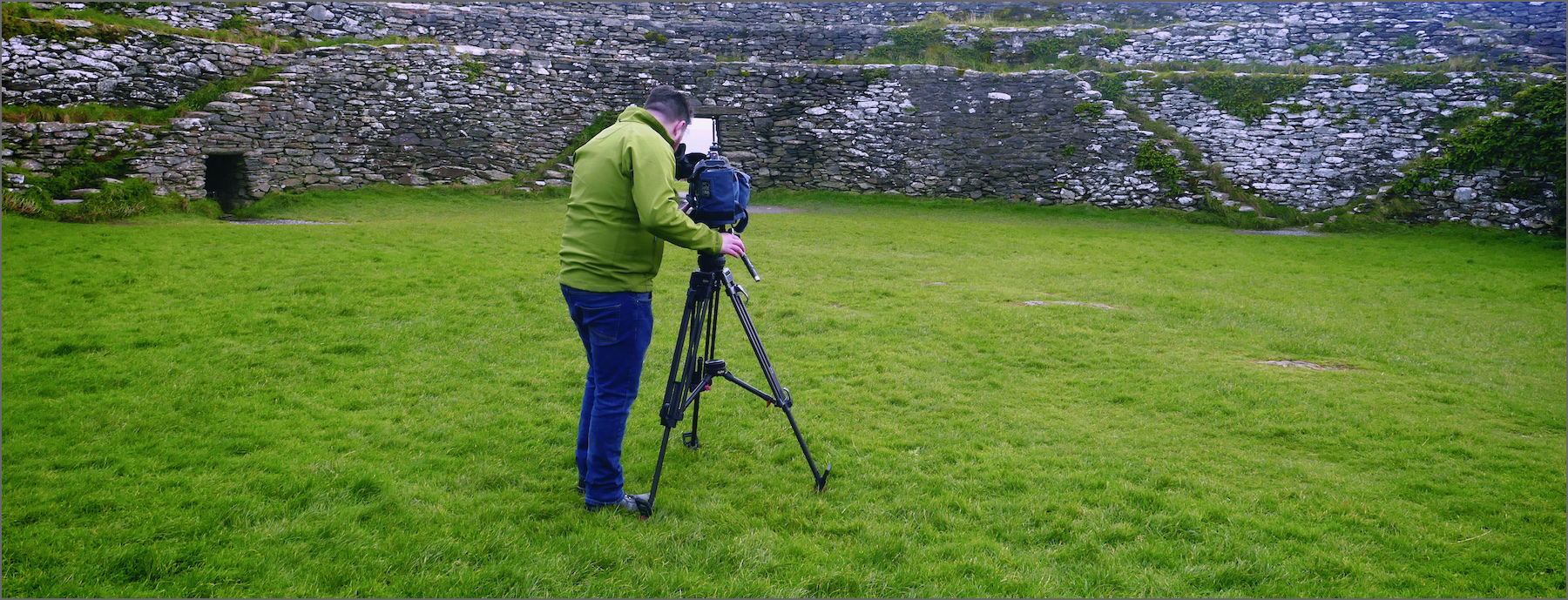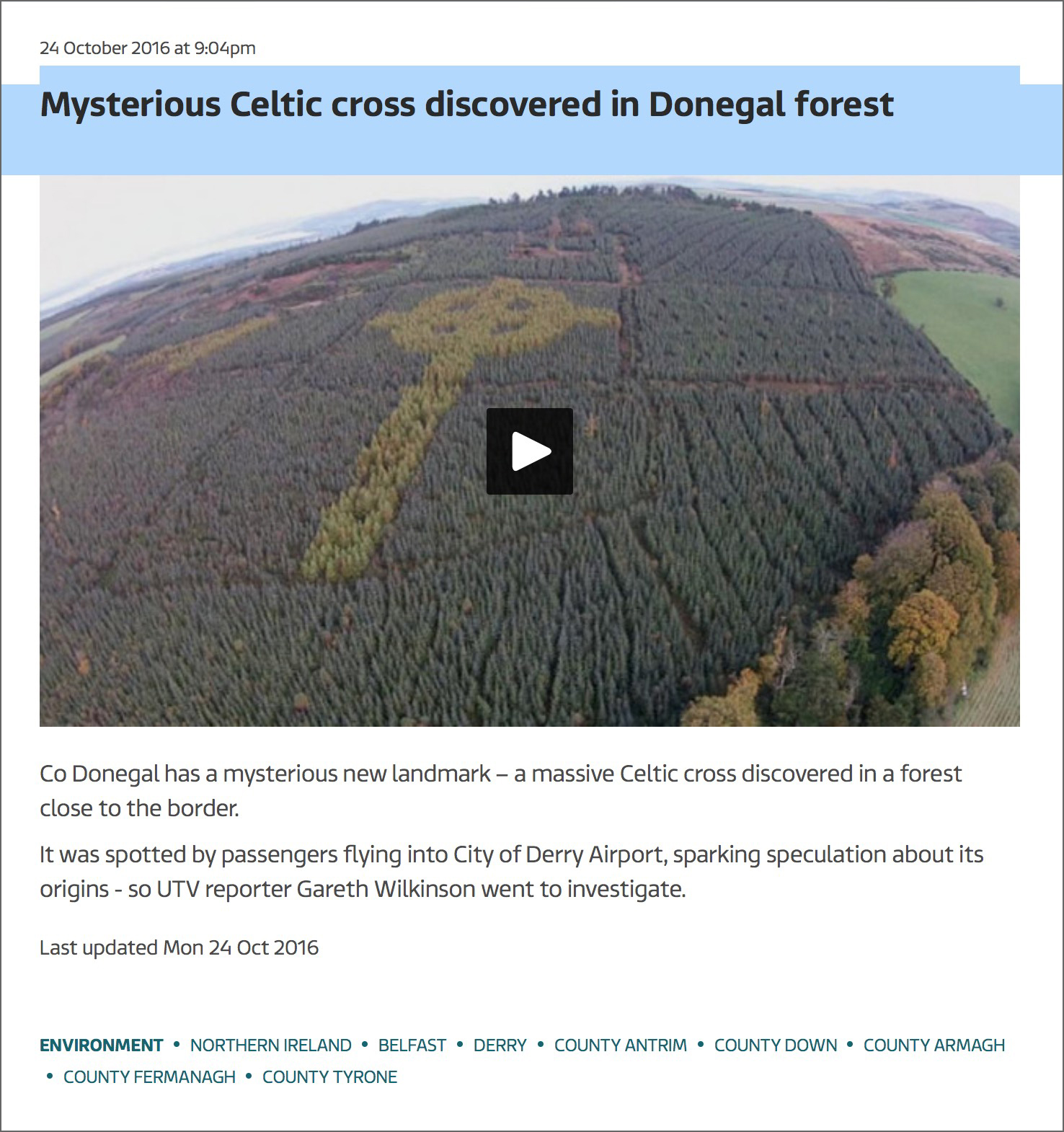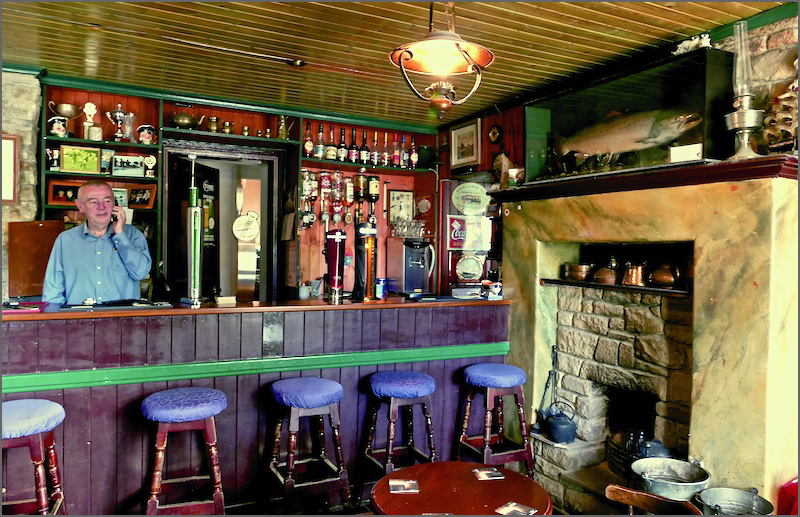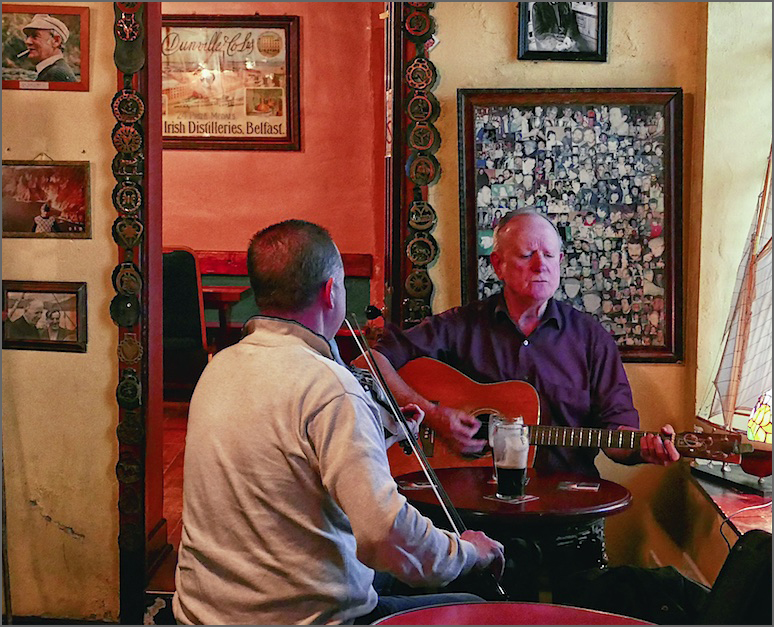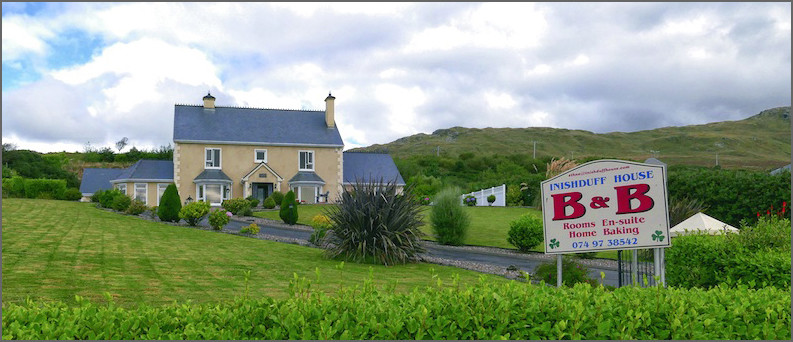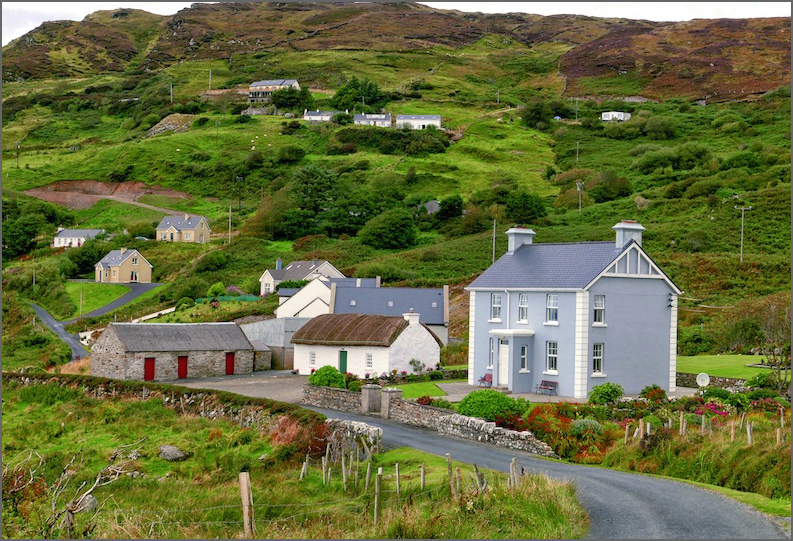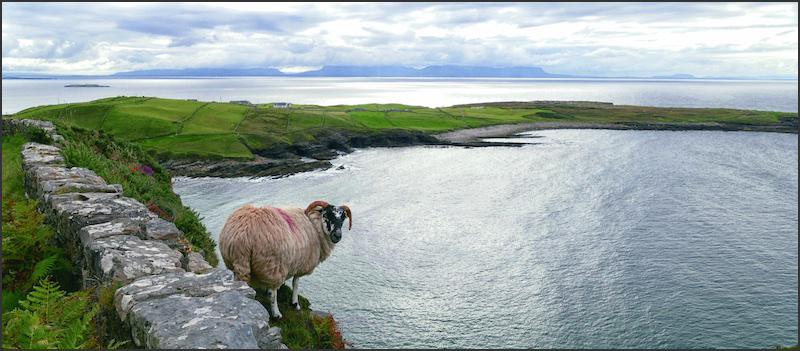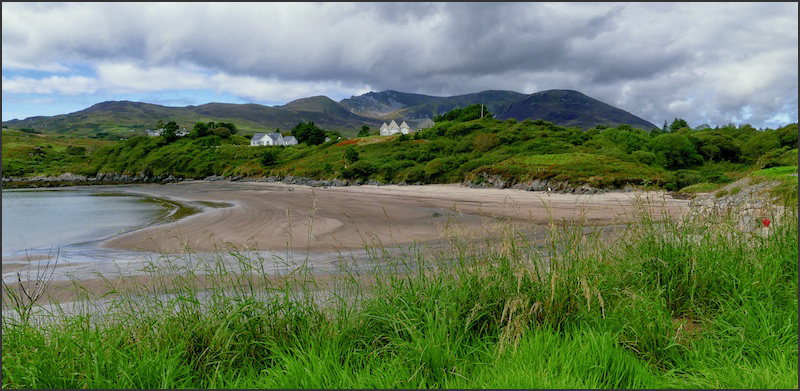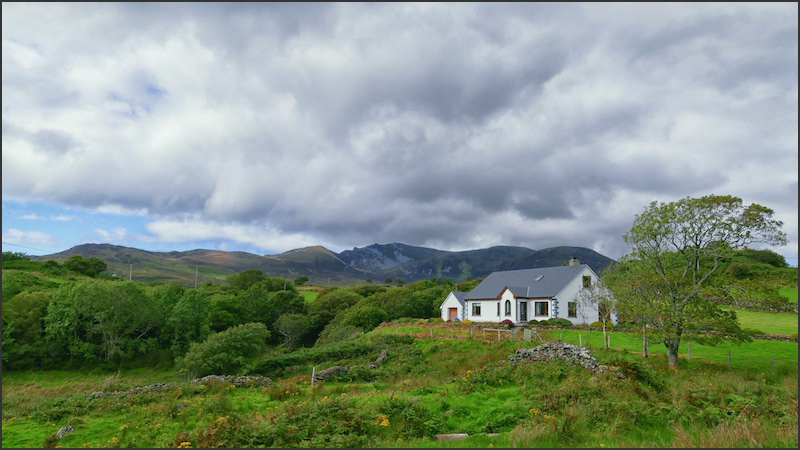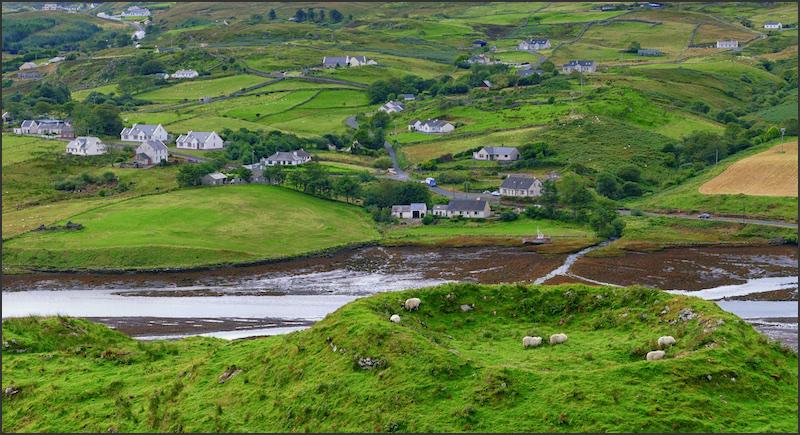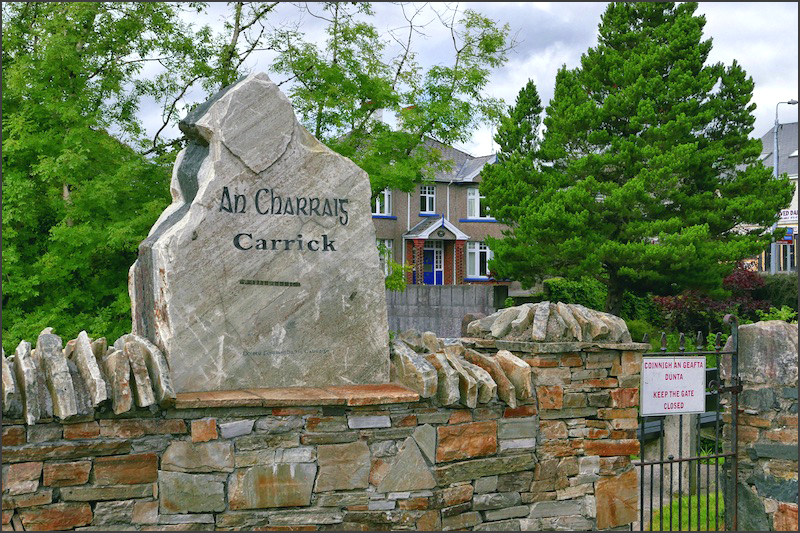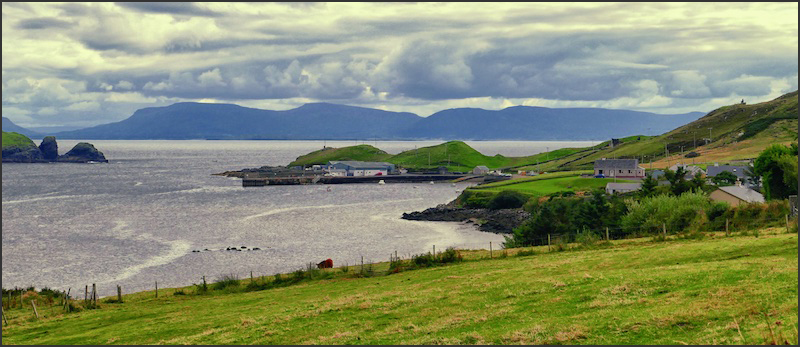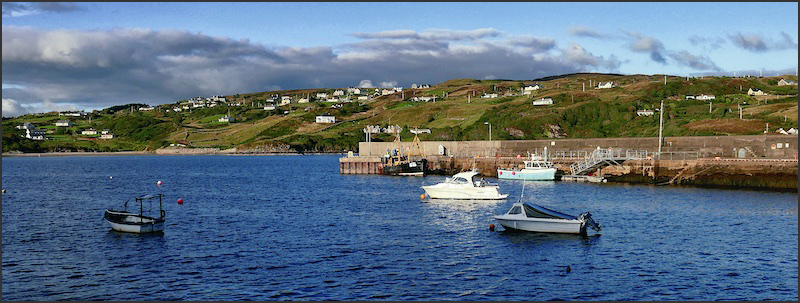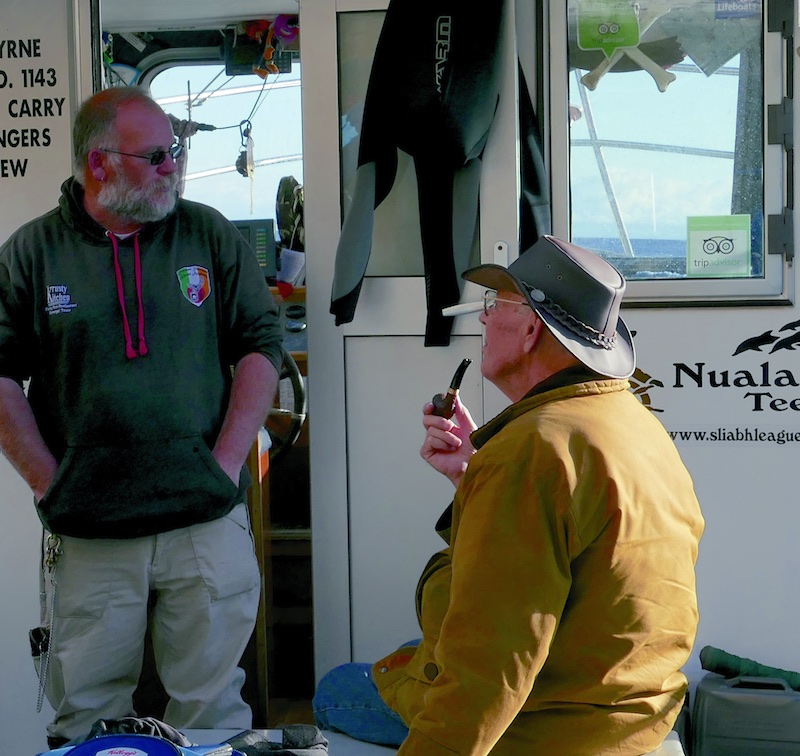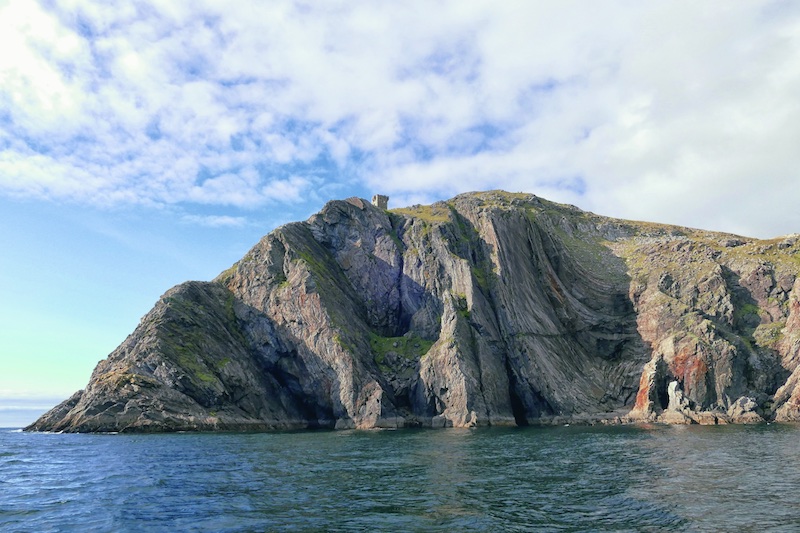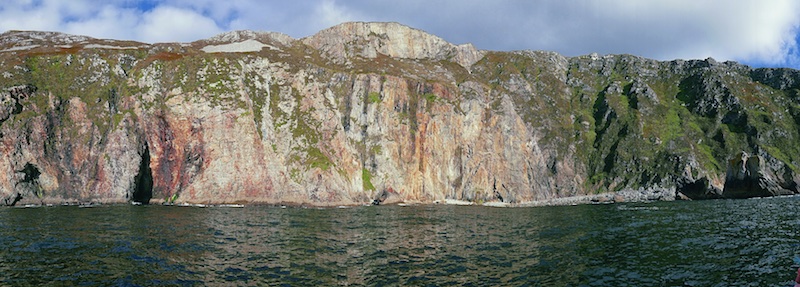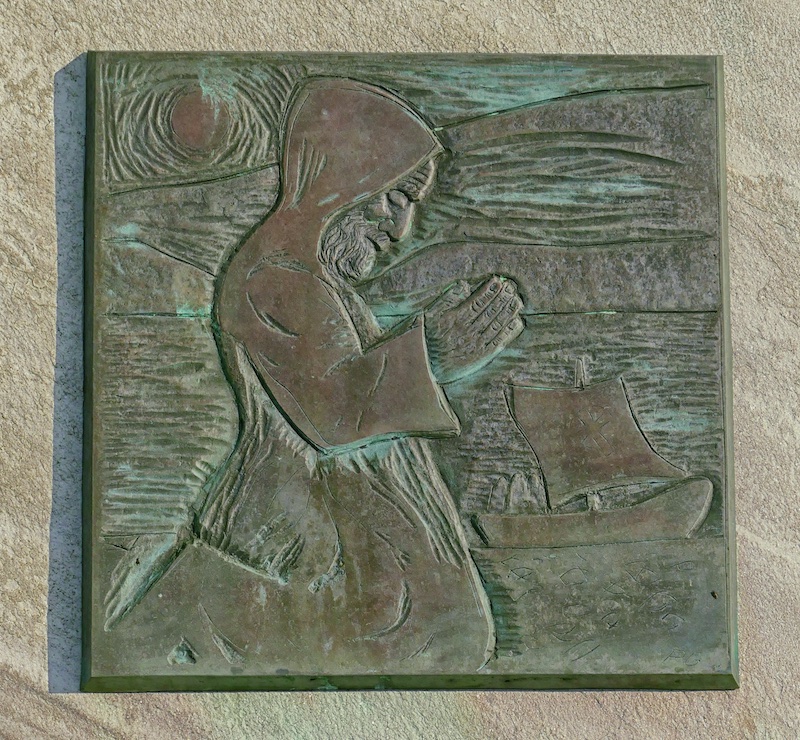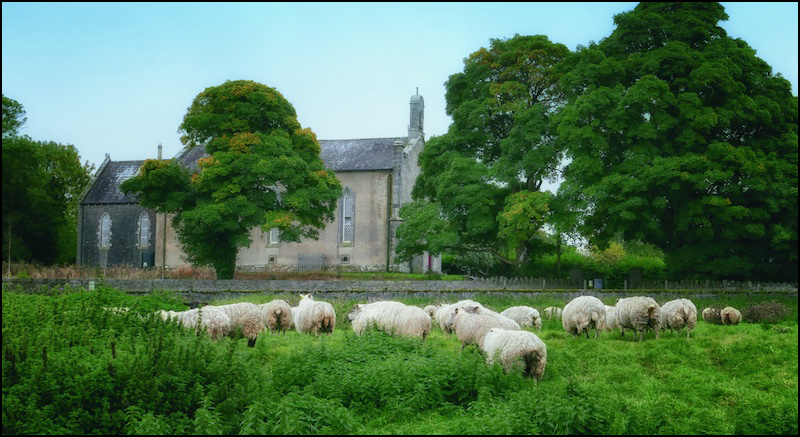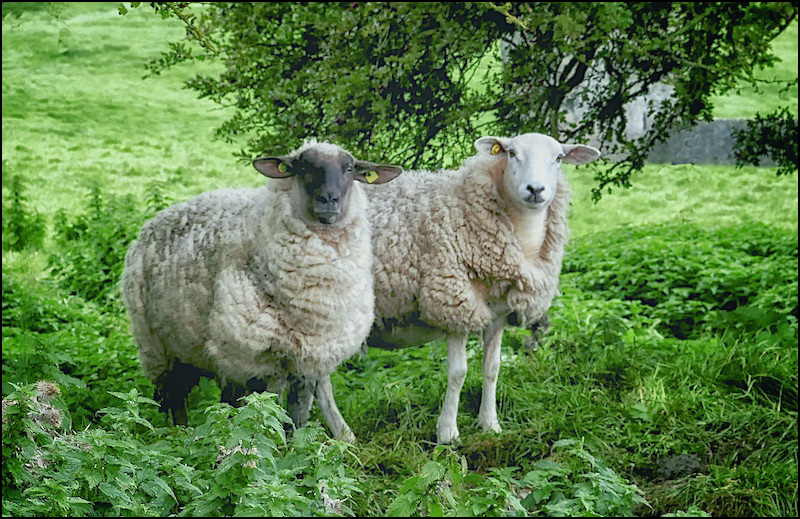A Chance Encounter at “Grianán of Aileach”
Saturday, November 5th, 2016
During our stay in Greencastle, in the northeast of Donegal’s Inishowen Peninsula, Jim and I set off one morning to visit the ancient ringfort at Grianán of Aileach, a group of historic structures atop a 244-meter hill near the Inishowen village of Burt.
Just before we reached the hilltop, I stopped to photograph the breathtaking autumn fields cascading down to the ocean loughs that define the peninsula.
The Grianán of Aileach ringfort (Stoney House of the Sun), is thought to be Ireland’s first earthen-wall enclosure. Early ruins on the site date back to 1700 BC and are linked to the Tuatha de Danann, who invaded Ireland before the Celts constructed stone forts on top of strategic hills. It was built by the Daghda, the celebrated king of the Tuatha De Danann and erected around the grave of his son, Aedh, who had been killed by Corrgenn, a Connacht chieftain.
Once we parked alongside the fort, I made a mad dash from the car to the entrance leading into the structure because the hilltop wind was about to knock me off my feet. As I neared the entrance, I was momentarily startled to hear voices coming from inside the fort. Those voices belonged to Gareth Wilkinson, a journalist from UTV, a commercial television station just over the border in Derry, Northern Ireland, and his cameraman, Ian Struthers, who was busy filming.
After a pleasant chat (shouting above the wind), the two gentlemen obliged me by standing alongside of the structure to provide a sense of scale of the fort that stands as a silent witness to the unfolding of Irish history.
Some weeks after we returned to Pennsylvania, I received an email from Gareth explaining that he and Ian had to return to the fort to reshoot the video because of the terrible wind that was whipping on the day we met. He also sent a link showing the brief clip that appeared in a perfectly wonderful UTV feature Gareth presented about a living Celtic cross planted years ago by a Donegal forester. It now stands as a tribute to his memory for the gift he has given to all who see it. At this link you can view his feature about the cross that now graces what Gareth so aptly describes as Donegal’s “majestic, mystical landscape.”
. . . . . . . . . . . . . . . . . . . . . . . . . . . . . . . . . . . . . . . . . . . . . . . . . . . . . . . . . . . . . . . . . . . . . . . . . . . . . . . . . . . . . . . . . . . .
Grace and the Easter Rising: One Hundred Years Ago
Monday, March 28th, 2016
Today, the Republic of Ireland held official ceremonies marking the 100th anniversary of the the “Easter Rising,” the armed insurrection during Easter Week, 1916, by Irish Republicans seeking to achieve Ireland’s independence from England. When the Irish rebels surrendered a week later, the leaders of the rebellion were executed by firing squad. One of them was a journalist, writer and poet named Joseph Plunkett, who was graduated from University College Dublin with degree in Philosophy. Joseph was supposed to marry his finance, Grace Gifford, on Easter Day, but the wedding was postponed because of The Rising.
I knew only a bit of Irish history when Jim and I first visited Ireland, but mainly it was of the more recent “Troubles,” but not much about the many centuries of struggle before 1916 and its aftermath. I knew nothing about Joseph and Grace and their wedding that took place in Kilmainham Jail the day before he was executed. During our second visit to County Clare, I head beautiful ballad entitled “Grace,” during a live music session in Doolin. The melody is haunting, and the words tell of Grace going to see Joseph for the last time, and his words to her, shortly before he was executed on the May 4, 1916.
Years later I sat down at a used piano in a second-hand shop and started to play “Grace,” which I had learned to play by ear. A middle-aged woman came over to listen, and she had tears in her eyes when she said, “I haven’t heard that beautiful song in many years.” She and her husband had immigrated to Pennsylvania as a young couple. I think of her every time I hear the song or play it.
“Grace” is beautifully sung by tenor Anthony Kearns in the video below. For me, it is a fitting commemoration for the events of 1916, one hundred years ago.
I had to do some searching to find the authors of the song; they are brothers Frank and Sean O’Meara, who, according to a letter written by Sean, noted that it was composed in 1985. You can read the letter on this website that is devoted to Grace Gifford Plunkett, and the O’Meara’s song lyrics are posted below. I also discovered that the song’s reference to these lines — And I’ll write some words upon the wall so everyone will know / I loved so much that I could see his blood upon the rose — are a reference to Plunkett’s poem “See His Blood Upon The Rose,” the lyrics of which are posted at at this link.
Grace
As we gather in the chapel here in old Kilmainham Jail
I think about these past few weeks, oh will they say we’ve failed?
From our school days they have told us we must yearn for liberty
Yet all I want in this dark place is to have you here with me
Oh Grace just hold me in your arms and let this moment linger
They’ll take me out at dawn and I will die
With all my love I place this wedding ring upon your finger
There won’t be time to share our love for we must say goodbye
Now I know it’s hard for you my love to ever understand
The love I bare for these brave men, the love for my dear land
But when Pádraic called me to his side down in the GPO
I had to leave my own sick bed, to him I had to go
Oh, Grace just hold me in your arms and let this moment linger
They’ll take me out at dawn and I will die
With all my love I’ll place this wedding ring upon your finger
There won’t be time to share our love for we must say goodbye.
Now as the dawn is breaking, my heart is breaking too
On this May morn as I walk out, my thoughts will be of you
And I’ll write some words upon the wall so everyone will know
I loved so much that I could see his blood upon the rose.
Oh, Grace just hold me in your arms and let this moment linger
They’ll take me out at dawn and I will die
With all my love I’ll place this wedding ring upon your finger
There won’t be time to share our love for we must say goodbye
For we must say goodbye.
. . . . . . . . . . . . . . . . . . . . . . . . . . . . . . . . . . . . . . . . . . . . . . . . . . . . . . . . . . . . . . . . . . . . . . . . . . . . . . . . . . . . . . . . . . . .
A Musical Tribute for St. Patrick‘s Day
Thursday, March 17th, 2016
To celebrate St. Patrick’s Day, I decided to post a musical tribute in the form of a video of one of my favorite contemporary Irish songs, “Bright Blue Rose.” In my music library I have versions of it by Tommy Fleming and Mary Black, but I also love this video by the songwriter himself, Jimmy MacCarthy, joined by the great Christy Moore and wonderful slide guitarist Declan Sinnott. What I like so about this video is that it is pretty close to the kind of intimacy you enjoy when musicians—famous or not-so-much—decide to gather in a pub to play and sing.
During our trip to Donegal last fall Jim and I dropped into The Rusty Mackerel, a cozy pub on the road to Teelin Harbour, where we took a pleasant boat trip to Slieve League.
I loved the pub’s rustic atmosphere, so we were happy to return in the evening to hear some excellent local musicians.
Much to my delight, one of the tunes they played was a lovely version of “Bright Blue Rose.” I was not in good position to video the performance, but I did get this still:
Here’s the “Bright Blue Rose” video that I referenced earlier. I love to hear a composer sing and play his own song; in this case, Jimmy takes the lead and Christie follows.
If you like the song, you might enjoy listening to the versions by Tommy Fleming and Mary Black .
I’ve also posted the lyrics below, along with a link to a MudCat Cafe discussion of the lyrics’ meaning. The Café is an online discussion group and song and tune database, which also includes many other features relating to folk music. It’s interesting that this song provokes so many interpretations. To me it is simply a beautiful song about redemption.
Bright Blue Rose
I skimmed across black water
Without once submerging
Onto the banks of an urban morning
That hungers the first light
Much, much more than mountains ever do
And she, like a ghost beside me
Goes down with the ease of a dolphin
And awakens unlearned, unshamed, unharmed
For she is the perfect creature, natural in every feature
And I am the geek with the alchemists’ stone
For all of you who must discover
For all who seek to understand
For having left the path of others
You’ll find a very special hand
And it is a holy thing
And it is a precious time
And it is the only way
Forget-me-nots among the snow
It’s always been, and so it goes
To ponder his death and his life eternally
For all of you who must discover
For all who seek to understand
For having left the path of others
You’ll find a very special hand
And it is a holy thing
And it is a precious time
And it is the only way
Forget-me-nots among the snow
It’s always been, and so it goes
To ponder his death and his life eternally
One bright blue rose outlives all those
Two thousand years, and still it goes
To ponder his death and his life eternally
Happy St. Patrick’s Day!
. . . . . . . . . . . . . . . . . . . . . . . . . . . . . . . . . . . . . . . . . . . . . . . . . . . . . . . . . . . . . . . . . . . . . . . . . . . . . . . . . . . . . . . . . . . .
A Lovely Day’s Journey to Donegal’s Cliffs of Slieve League
Sunday, February 28th, 2016
A real highlight of last fall’s trip to Ireland was a visit to the dramatic cliffs of Slieve League, a magnificent mountain on the Atlantic coast of Donegal. Although less famous than the Cliffs of Moher in County Clare, Slieve League’s cliffs reach almost three times higher. We were told that the best view of of the cliffs is from the water, so we set off for nearby Teelin Harbour, home of Slieve League Boat Trips. The drive to get there was delightfully scenic.
We left from our home base at the wonderful Inishduff House in Kilcar, and made a leisurely drive north along the coast road that wound past charming homes, old and new . . . nestled together or standing apart, above beaches and inlets, skirting villages, and alerting several sheep that were curious enough to stand by on a precarious perch or look on from a leafy glade to watch me make photographs.
By the time the tiny fishing village of Teelin was in sight, the clouds had rolled in, and the weather looked threatening, but we carried on, deciding that rain or shine we would make the cruise.
As so often is the case in Ireland, within minutes of arriving across from the pier where the 24-person Nuala Star cruise boat was moored, the sun had broken through to reveal Teelin Harbour in all its glory. It was interesting to learn that Teelin is one of the first settlements to appear on maps of Ireland.
After leaving the shelter of Teelin Harbour, it was only a short cruise along the Atlantic Ocean coast before the lush green hills transitioned into grey-rocked cliffs.
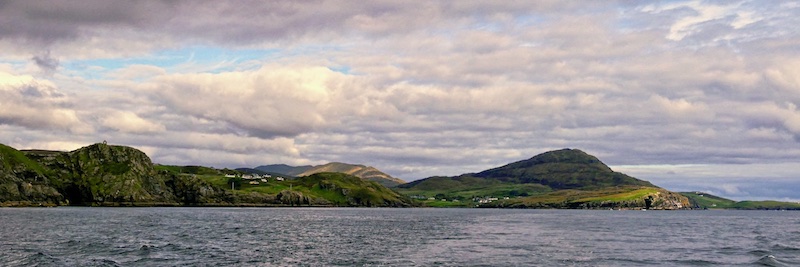
Once Sleeve League came into full view, the mountain appeared just as Belfast naturalist Robert Lloyd Praeger described it in 1939: “A tall mountain of nearly 2000 feet, precipitous on its northern side, has been devoured by the sea till the southern face forms a precipice likewise, descending on this side right into the Atlantic from the long knife-edge which forms the summit.”
I used the auto pano feature of my Lumix FZ1000 to capture the seaside view of the cliffs below.
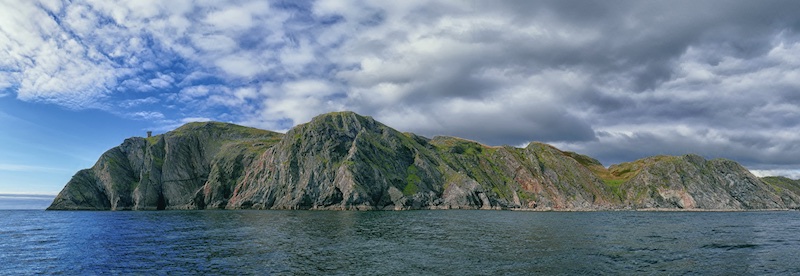
It’s hard to get a sense of scale of the cliffs either from the sea or in photographs, so it was helpful to hear Nuala Star Captain Paddy Byrne, shown below, explain to Jim that at its highest point, Slieve League is taller than the Empire State Building by some 75 stories.
Paddy also pointed out that signal Towers on Slieve League cliffs were built by the British to warn villagers of any possible encroachments by the French army under Napoleon during the early 19th century.
I got a better look at one of the towers through the “digital zoom” function of the FZ1000 that effectively extends the fixed super-zoom (25mm to 400mm) lens magnification well beyond the 400mm end, which really comes in handy in situations such as this.
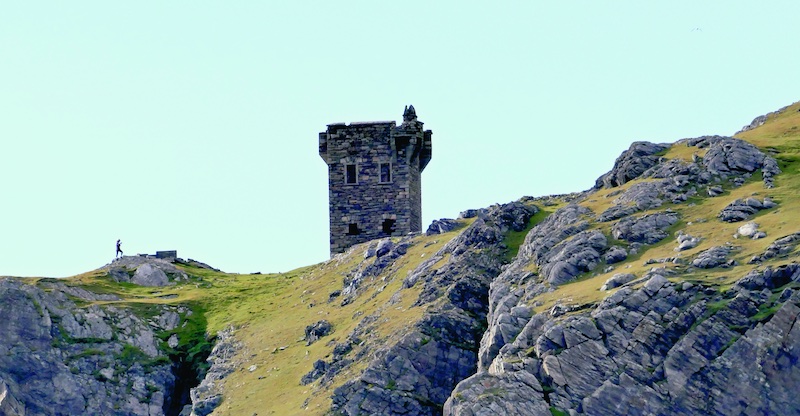
On the trip back, the Nuala Star hugged the coastline so that we could get a good look at the mountain’s beaches and sea caves.
Once back in the harbour we noticed the remains of an old church that stands beside the pier marking the spot where a community of 5th century Teelin monks lived before they undertook the precarious seajourney to Iceland, an extraordinary undertaking by the standards of that time. Along side of the ruins is this lovely stone carving that honors the monks with a plaque that reads: “In memory of the Teelin monks who sailed to Iceland in the 5th Century.”
In the future, I hope to return to Slieve League on a dull, overcast day to capture the true wildness of the countryside both on top of the mountain and below it on the shore. I suspect that on such days you will sense the ancient rhythm of the waves crashing into this magnificent mountain, as they have done for so many centuries. It is fascinating to recognize that what we see today when we gaze upon Sleeve League is exactly what the very first men and women saw when they found their way to this mesmerizing land.
. . . . . . . . . . . . . . . . . . . . . . . . . . . . . . . . . . . . . . . . . . . . . . . . . . . . . . . . . . . . . . . . . . . . . . . . . . . . . . . . . . . . . . . . . . . .
Some Sheep and a Little History
Thursday, January 28th, 2016
During our wonderful visit to Suzanna Crampton’s farm to photograph her Zwartbles flock (see previous post), I asked Suzanna if there were any scenic venues nearby where I might find other sheep to photograph. She suggested that we stop by Kells Priory, which was a short distance from her farm. Maria Dunphy kindly led us to the location, and oh, yes, there were plenty of sheep!
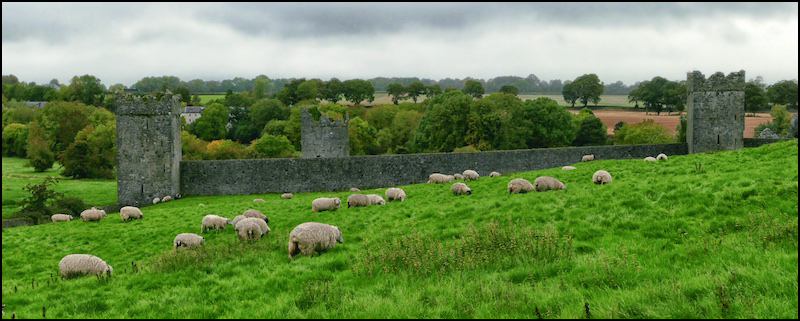
The Augustine priory, the walls of which date back to the 1300s, is situated alongside King’s River next to the village of Kells, about 15 km south of the medieval city of Kilkenny. The priory is a National Monument under the guardianship of the Office of Public Works. One of its most striking features is a collection of medieval tower houses spaced at intervals along and within walls that enclose a site of just over three acres. These towers give the priory the appearance more of a fortress than of a place of worship. A large flock of sheep wander these acres, and since it was easy for me to climb over a low-walled section, I wandered around with them. They didn’t seem to mind.
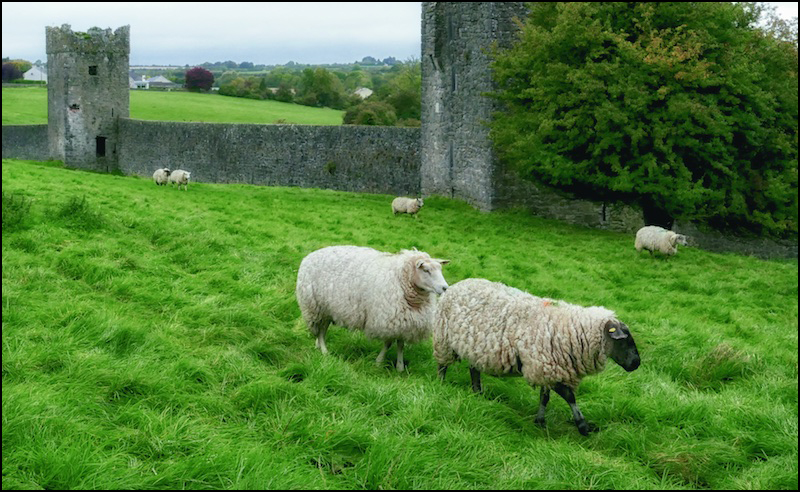

The priory is divided into two parts, an inner monastic “Precinct” alongside the river, and a large outer enclosure to the south known as “Burgher’s Court.” Today all the monastic remains are grouped together in the Precinct while Burgess Court is little more than the walled field populated by sheep and tourists like me.
In reading about its history, I discovered that Kells Priory was associated with a 1324 witchcraft trial that resulted in a noblewoman, Petronilla de Meath, becoming Ireland’s first heretic to be burned at the stake. In March 1540 the church and property were surrendered to James Butler, 9th Earl of Ormonde, a result of English King Henry VIII’s Dissolution of the Monasteries, one of the most revolutionary events in English history.
. . . . . . . . . . . . . . . . . . . . . . . . . . . . . . . . . . . . . . . . . . . . . . . . . . . . . . . . . . . . . . . . . . . . . . . . . . . . . . . . . . . . . . . . . . . .
« Newer Older »



